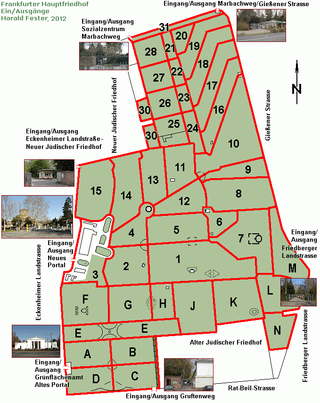
Karl Friedrich Lessing was a German historical and landscape painter, grandnephew of Gotthold Ephraim Lessing and one of the main exponents of the Düsseldorf school of painting.

The Friedhof Heerstraße cemetery is located at Trakehnerallee 1, district of Charlottenburg-Wilmersdorf in Berlin, Germany, to the east of the Olympiastadion. It covers an area of 149,650 square meters.

The Waldfriedhof Dahlem is a cemetery in Berlin, in the district of Steglitz-Zehlendorf on the edge of the Grunewald forest at Hüttenweg 47. Densely planted with conifers and designed between 1931 and 1933 after the plans of Albert Brodersen, it is one of Berlin's more recent cemeteries. Its graves include those of writers such as Gottfried Benn, composers such as Wolfgang Werner Eisbrenner and entertainers like Harald Juhnke, and put it among the so-called "Prominentenfriedhöfe" or celebrity cemeteries.

The Alter Südfriedhof also known as "Alter Südlicher Friedhof" is a cemetery in Munich, Germany. It was founded by Duke Albrecht V as a plague cemetery in 1563 about half a kilometer south of the Sendlinger Gate between Thalkirchner and Pestalozzistraße.
Events in the year 1888 in Germany, the 'Year of the Three Emperors'.
Events in the year 1930 in Germany.
Events in the year 1907 in Germany.
Events in the year 1905 in Germany.
Events from the year 1880 in Germany.
Events in the year 1883 in Germany.

The Alter Nordfriedhof is a former cemetery located in the Arcisstrasse in Maxvorstadt, Munich, Bavaria, Germany. It is not to be confused with the Nordfriedhof in Munich, which was set up only a short time later in Schwabing. Construction began in 1866 to designs by the city architect Arnold Zenetti.

Melaten is the central cemetery of Cologne, North Rhine-Westphalia, which was first mentioned in 1243. It was developed to a large park, holding the graves of notable residents.

The Nordfriedhof, with 34,000 burial plots, is one of the largest cemeteries in Munich, Bavaria, Germany. It is situated in the suburb of Schwabing-Freimann. It was established by the former community of Schwabing in 1884. It is not to be confused with the Alter Nordfriedhof in Munich, which was set up only a short time previously within the then territory of the city of Munich.

Loschwitz Cemetery is the second burial ground, still in use, of Loschwitz, part of the city of Dresden, Germany, replacing the graveyard of Loschwitz church, no longer used for burials. The cemetery was dedicated in about 1800. Because of the many artists buried here and the many artistically valuable funerary sculptures it is a protected monument.

Waldfriedhof Zehlendorf is a cemetery located in Berlin's Nikolassee district. The cemetery occupies an area of 376,975 m2. An additional Italian war cemetery was created there in 1953. A number of notable people of Berlin are buried at the cemetery; some have a grave of honor. In particular, all of Berlin's deceased post-war mayors are buried here.

Alter Friedhof is a historically significant cemetery in Bonn, Germany, 1.2 hectares in area, located near the center of the modern city.



























